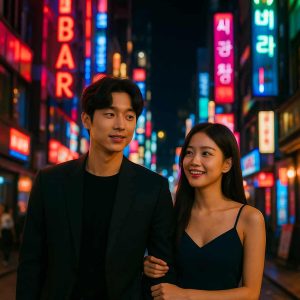 If you’ve ever watched a Korean drama set in Seoul, chances are you’ve seen the city sparkle like a cinematic dream. Neon lights reflect off black cars, stylish characters toast with champagne in rooftop lounges, and every night seems to unfold in high heels and tailored suits. It’s not just storytelling—it’s a subtle showcase of how Seoul wants to be seen: sleek, affluent, and endlessly alive after dark.
If you’ve ever watched a Korean drama set in Seoul, chances are you’ve seen the city sparkle like a cinematic dream. Neon lights reflect off black cars, stylish characters toast with champagne in rooftop lounges, and every night seems to unfold in high heels and tailored suits. It’s not just storytelling—it’s a subtle showcase of how Seoul wants to be seen: sleek, affluent, and endlessly alive after dark.
Korean dramas have long been more than entertainment. They’re a form of cultural export, a lens through which global viewers experience South Korea. But beyond their tightly written plots and attractive casts, these shows often serve as travel brochures for the capital’s most glamorous districts—Gangnam, Itaewon, and Cheongdam in particular—frequently featuring lively 가라오케 scenes that capture the country’s vibrant nightlife culture.
In dramas like Itaewon Class, The Heirs, and My Love from the Star, Seoul isn’t just a backdrop. It’s a co-star, dressed in designer lighting and dripping with the energy of youth and success. Rooftop bars with panoramic city views, private lounges tucked behind unmarked doors, and restaurant scenes where wine flows as freely as dialogue—these visual cues shape how millions of viewers, both local and international, imagine the “Korean dream.”
The city’s nightlife, as depicted on screen, becomes a metaphor for social mobility and sophistication. The glow of Gangnam’s skyline reflects not just light but ambition—an aesthetic shorthand for making it in modern Seoul.
The Power of the Scene
This glamorization isn’t accidental. Korean entertainment production often involves subtle collaboration between media companies and real businesses. Bars, restaurants, and clubs featured in dramas are frequently actual venues, chosen for their sleek design or celebrity clientele. The exposure can transform a local lounge into a global hotspot overnight.
When Descendants of the Sun featured the Dal.komm Café chain, sales spiked. Similarly, after Crash Landing on You showcased the swanky interiors of certain Seoul restaurants, those locations saw surges in foreign visitors. Even if the storylines don’t explicitly advertise the venues, the visual language of luxury—soft lighting, modern architecture, elegantly plated dishes—creates instant desirability.
It’s soft power marketing at its most seamless. K-dramas sell not only love stories but lifestyles. And nightlife, in this cinematic universe, is where characters prove they belong to that world.
A Carefully Curated Fantasy
Of course, the real Seoul nightlife is more layered than what’s shown on screen. While Gangnam and Itaewon indeed host lavish rooftop bars and VIP clubs, most residents experience the city’s evenings through simpler pleasures—late-night street food, karaoke rooms, and tiny bars down quiet alleys.
But K-dramas aren’t documentaries. They curate. The dimly lit whiskey bar where the lead couple finally confesses their feelings isn’t meant to represent the average night out—it’s a visual shorthand for emotional intimacy and aspiration. These shows construct a fantasy of Seoul that’s both believable and elevated, blending urban realism with cinematic perfection.
That fantasy has global appeal. For international viewers, Seoul becomes an emblem of modernity and fabulous—a city where nightlife is not just entertainment but identity. For locals, it reflects an aspirational lifestyle that feels within reach, if only for a moment.
The Rise of “Set-jetting”
The blending of fiction and tourism has created a phenomenon known as “set-jetting,” where fans travel to filming locations to experience scenes firsthand. Seoul’s nightlife has benefited enormously from this. Bars like J. Hidden House in Gangnam or The Griffin Bar in Myeongdong have seen waves of visitors who recognized them from dramas.
Variety shows like Running Man and Single’s Inferno further amplify this effect, turning real venues into recognizable pop-culture landmarks. The show’s slick editing and celebrity appearances transform Seoul’s nightlife into something aspirational yet attainable—viewers can, quite literally, drink where their favorite stars did.
Tourism agencies have taken note. The Seoul Metropolitan Government often collaborates with drama producers to feature iconic locations, blurring the line between narrative and promotion. In this way, entertainment becomes both cultural diplomacy and urban marketing.
The Hidden Costs of Glamour
Yet, this romanticized portrayal raises questions about authenticity and accessibility. The nightlife shown in K-dramas is almost always exclusive—private lounges, designer cocktails, and elite social circles. It’s an image of Seoul that prioritizes luxury over diversity, subtly reinforcing social hierarchies that dramas themselves often critique.
The emphasis on material success, as reflected in nightlife aesthetics, can also pressure younger audiences. When every romantic confession happens under the glow of designer lighting, it’s easy to associate love and happiness with affluence. The cinematic Seoul becomes an idealized playground for the beautiful and successful—an image far removed from the city’s everyday realities.
Beyond the Neon
Still, there’s no denying that the strategy works. Seoul’s nightlife, thanks to the lens of K-dramas and variety shows, has become a symbol of contemporary Korean culture—modern, confident, and visually stunning. What was once a local scene is now part of a global fantasy, one that draws tourists, investors, and dreamers alike.
The city’s skyline, with its shifting lights and endless rhythm, embodies the essence of the Korean Wave: ambition dressed as entertainment. K-dramas don’t just tell stories; they sell experiences. And Seoul, as portrayed through their lens, is the ultimate set—alive, seductive, and waiting for its next close-up.

